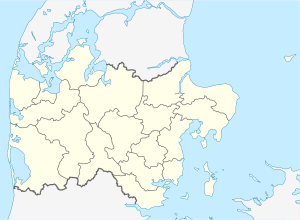Ejer Bavnehøj
| Ejer Bavnehøj | ||
|---|---|---|
|
Reunification Tower (Genforeningstårnet) on Ejer Bavnehøj (2008) |
||
| height | 170.35 m | |
| location | Denmark | |
| Coordinates | 55 ° 58 '37 " N , 9 ° 49' 50" E | |
|
|
||
| rock | limestone | |
| particularities | National memorial, lookout tower, tumulus group | |
The Ejer Bavnehøj [ ɑi̯əʀ ˈbɑu̯nəhɔi̯ʔ ] (also Ejer Baunehøj ) near Skanderborg in Jutland is the third highest natural elevation in Denmark at 170.35 m . The 51 cm higher Møllehøj is only about 200 m away on the same ridge and measures 170.86 m. This makes it the highest natural elevation in the country.
Height determination
Yding Skovhøj (172.54 m) was officially the highest point until 2004 . On the top of Yding Skovhøj, however, there is a burial mound from the Bronze Age , i.e. a human structure which, according to the geodesists, should not be included in the height measurement. Without the burial mound, its exact height, determined by drilling, is 170.77 m. That makes it the second highest natural elevation in Denmark.
history
The already mentioned barrow field shows the early settlement of the landscape. In the Middle Ages, the mountain was used at times as a signal station to transmit messages by means of agreed fire or light signals. In the 19th century there were military guards on the mountain top during wartime, for example during the German-Danish War.
The Danish land surveying used the hill dome in the 19th century as the basis of the topographical network of fixed points. The ridge has been under landscape protection since 1917.
The national joy over the "reunification" with South Jutland as a result of the referendum in Schleswig after the First World War led in 1920 to the setting of a memorial stone on the mountain top. On the first anniversary of the inauguration of the monument, the Danish King Christian X attended the jubilee ceremony and thus attracted many thousands of visitors.
A collection organized by Danish national associations in 1924 was used to build a national monument in the form of a lookout tower. The Genforeningstårnet is 12.5 m high and, according to the initiators, is made up of two connected triumphal arches. The monumental insignificance met with harsh criticism among Danish architects in the 1920s and was given the nickname “Chimney of Jutland”. In 1975 the municipality of Skanderborg acquired the monument.
According to Danish tradition, representatives from all Danish regions meet at the memorial every year on the fourth weekend in August to celebrate the day of reunification.
In the summer of 2015, the municipality of Skanderborg decided to upgrade with the financial support of the Fonds Realdania Ejer Bavnehøj with an information point and a kiosk. The project should be completed by the end of 2016.
View from the E 45 to the Ejer Bavnehøj (2004)
See also
Individual evidence
- ^ Inge Adriansen: Erindringssteder i Danmark , 2011.
literature
- Inge Adriansen: Erindringssteder i Danmark. Monumenter, mindesmærker og mødesteder , Museum Tusculanum, Copenhagen 2011. ISBN 978-87-635-3173-3 .
- Lars Lassen (Ed.): Skanderborg Kommune . 6th edition. Skanderborg 2007, ISBN 87-991139-2-9 , pp. 264 (Danish).
Web links
- Ejer Bavnehøjs Venner: Welcome to Ejer Baunehøj (information in English)
- 360 degree panorama from the Reunification Tower


